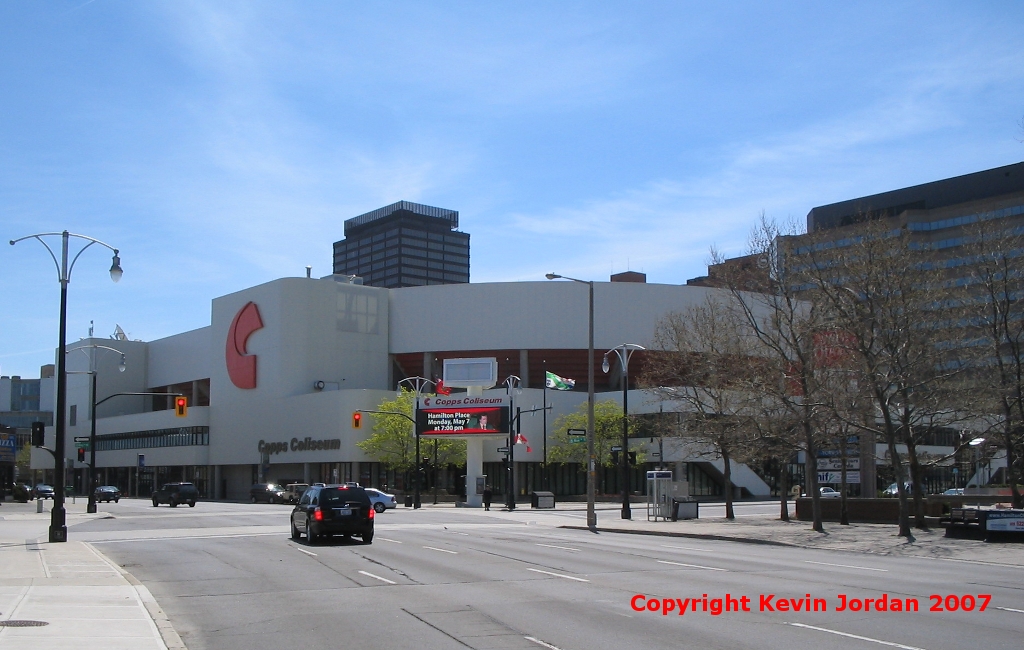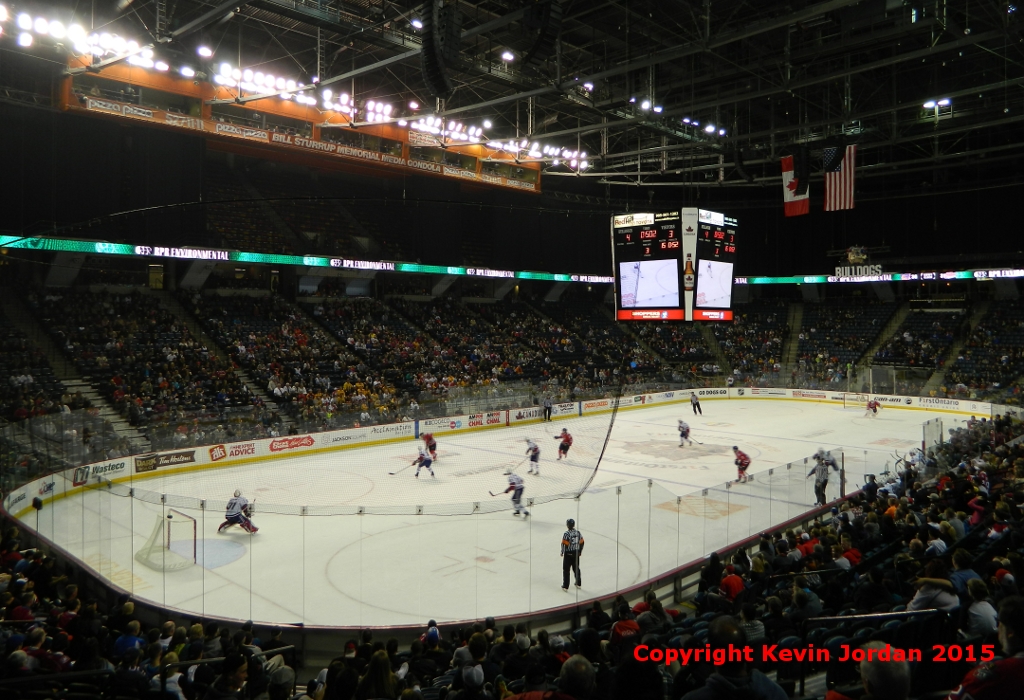
Hamilton Bulldogs
Arena Name: Copps Coliseum
Capacity: 17,500
Built: 1985
Address: 101 York Blvd. Hamilton, ON, L8R 3L4
Ice Surface Size: Regulation
Franchise Date: 2015
Last Game: 2023

Copps Coliseum

What's the Arena Like?
First Visit: December 27, 2004 for AHL; September 26, 2015 for OHL
CHL Arena: 41
OHL Arena: 29
Copps Coliseum was the mid-1980's platonic ideal of the perfect NHL arena, closely resembling other similar vintage NHL and former NHL buildings like Joe Louis Arena, Brendan Byrne Arena and the Nassau Coliseum. It was constructed to replace the old Hamilton Forum a mere eight years after that building was condemned and demolished, and as with so many other things Hamilton, what was built was both too late and completely wrong when it was finally completed.
Hamilton's history with hockey is as convoluted and twisty as an M. Night Shyamalan movie. The city had an NHL team, the Tigers, back in the 1920's, and the pipe dream of someday getting the NHL back was what ultimately led to Copps Coliseum being built in the 1980's. But first, some back story. Hamilton's former OHL team, the Red Wings/Fincups, had a long history in Steeltown, winning the Memorial Cup in 1962 and 1976, but shortly after Dale McCourt led them to their second national title, the icemaking plant in the old "converted factory chimney" of an arena failed in late August of 1976. The Fincups were homeless, and when a last-ditch effort at securing a lease at the Mountain Arena failed to materialize after a campaign by local NIMBY activists, they moved to spend one season 40 miles down the road in St. Catharines. The Fincups finally did secure that lease on the Mountain for the 1977-78 season, but after a full year of unsuccessfully lobbying Hamilton city council to build a spectator arena (and remember, Hamilton spent the decade between 1976 and 1985 with no arena larger than a 2,500 capacity within the city limits), Fincup ownership sold out to Brantford and the team was lost.
After nearly a decade of dithering, Hamilton City Council finally decided to aim for the clouds in the early 1980's and built a state-of-the-art, world-class NHL arena downtown with the expressed intention of luring an NHL team to town. There was not, at the time, a deep-pocketed local owner with the intention of bringing the NHL to town; nor was Hamilton any more prosperous or attractive of a town to the NHL as it is today. But dreams are what they are, and the city financed constructing an arena that would easily have been among the finest in John Ziegler's NHL had any team been insane enough to actually move in. So that first season, Copps Coliseum hosted the OHL again (the Brantford Alexanders predictably failed in Brantford and moved back as the Hamilton Steelhawks, thus meaning the city had its original franchise back), some concerts and trade shows, and... that was pretty much it.
An NHL arena by definition is too large for nearly any other form of hockey. There are occasional NBA arenas that host AHL teams around the United States, but crowd noise dies in such places and atmosphere is generally nonexistent. The Steelhawks drew poorly enough in Copps in their 1980's residency, but by percentage of capacity it was far, far worse, and no one was surprised when ownership uprooted again in 1988 to move to Niagara Falls and become the Thunder. A few years later Hamilton had a new OHL team, the Dukes, about whom the less said, the better, and by 1991 junior hockey had abandoned one of its foundational cities, a city with a long and proud history of the game, and a city that in spite of its permanent economic malaise was still the third-largest in Ontario.
Then the next twenty-five years happened; the NHL never really seriously considered moving to Hamilton, and Copps aged to the point that apart from its capacity it is no longer really NHL-calibre. The city had an AHL team for a bunch of years or something, and they drew reasonably well with a deep-pocketed owner, but even as they averaged a perfectly respectable 5,000 or so, Copps was still generally never more than 1/3 full.
Then all of a sudden, one day in the late winter of 2015, the AHL's California expansion meant that the Bulldogs lost their affiliation and were unlikely to pick up another one, and lo and behold, the long-for-sale Belleville Bulls were available for some rich dude to overpay for and move. So now, twenty-five years later, Hamilton finally has an OHL team again, and the move happened so quickly that the new OHL Bulldogs spent their first OHL season wearing the same uniforms as the AHL team, and all elements of gameday presentation were pretty much the same as they were for the AHL.
The Bulldogs were incredibly successful in Hamilton, winning two championships and drawing very well by OHL standards in the cavernous building. Sure, atmosphere was poor most nights, but the city still embraced and supported the team. But Ontario's worst-managed major city managed to ruin it, yet again. As of 2023 Copps Coliseum is being extensively renovated, to right-size the rink for the market, but this means the arena will close for a minimum of two full seasons, and no provision was made to allow the tenants to continue using the building during construction. Only tiny Mountain Arena is anywhere even close to OHL standards in Hamilton, and so no one really blamed Michael Andlauer for taking his team twenty-five minutes down the highway to Brantford for the 2023-24 season and beyond. The Bulldogs have committed their future to Brantford, now, so what future hockey tenant returns to the new TD Coliseum when the renovations are complete is anyone's guess.
My original review of the Bulldogs experience at Copps follows:
In terms of the arena itself, Copps (or "FirstOntario Centre in honour of Victor K Copps", as we are all required to call it in casual conversation) is still the same big white elephant of a building in the centre of downtown Hamilton, minutes off the 403. It is done up in white cladding and accented in orange, with windows about the facade and the underside of the "steps" of the upper bowl visible from street level. It looks small in comparison with a lot of modern NHL arenas, though it's still easily the biggest arena in the OHL, with the lower bowl alone having more seats than any other rink in the league save London and Ottawa. The ticket office is on street level, and once you're inside you climb an escalator to get to the concourse. The concourse is the "single concourse clusterfuck" design so beloved of 1970's and 1980's arena architects, and the upper bowl is curtained off unless the team sells enough tickets to be worth opening it up (n.b: this basically never happens). Washrooms are plentiful and clean. Apart from the video board, there really aren't a lot of signs anywhere that it's not 1985 anymore.
The arena bowl is indistinguishable from any NHL building of 1980's vintage, with two massive decks making up the bulk of Copps Coliseum. When it was built, all of the seats were randomly coloured gaudy lemony yellow, grapety purple and orangey orange, but at some point since my last AHL visit in 2007 the lower bowl seats were replaced by comfortable, padded navy blue seats (you can still see the Bowl of Trix seats in the upper level). The scoreclock is four-sided and has a video board, and game presentation is far more professional than the Roman orgy of advertising and promotional giveaways that makes up today's OHL fan experience in many cities. This is a good thing - the higher standards of AHL game presentation have bled over to the OHL team, and one hopes they won't let that standard slip.
Considering the size of the building, the atmosphere isn't as terrible as you'd think. The Bulldogs draw reasonably well in terms of sheer numbers, if not in terms of percentage of the building's capacity, and for big games the fan support is loud and in your face, like any blue-collar hockey town. The limitations of having such a huge arena mean that the arena will never be one of the best atmospheres in the OHL, but it's not a bad experience, either. One hopes that right-sizing the arena with the upcoming renovations will help.
In my old Copps review I wrote that "The city's OHL days aren't forgotten, either - Memorial Cup banners from 1962 and 1976 hang from the ceiling", but as of my last visit to Copps in the 2018 OHL finals, the ceiling was still bare. One hopes that this was just a temporary oversight - connecting the Bulldogs to the city's long history with the OHL would be a significant step forward in promoting the team as Hamilton's own, not just one where any player who performs well is likely to be called up to the big club in Montreal or Edmonton. But with that said, while I lament the loss of the Belleville Bulls (and with it one of the last links to the OHL's small-town community roots), the league is better off for having a strong Hamilton franchise. For the first time, well, ever, the OHL has strong franchises in nearly every potential market in Ontario and the US border states, with only Elliott Kerr's Mississauga Steelheads being potential targets of a move.
FirstOntario Centre in Honour of Victor K. Copps is still too big, still a dated white elephant, and still not an ideal home to anyone but the NHL team that never materialized, but godspeed to the Bulldogs, and here's hoping they carry on the city's proud junior hockey tradition.
Inside Copps Coliseum

Future Developments
Copps Coliseum has never been the right building for any tenant apart from the NHL team that never came, and with every NHL team save Calgary now playing in a building that is either newer or has had literally a billion dollars in upgrades (looking at you, Madison Square Garden), it seems unlikely that it ever will. The arena management reported that they only open the upper bowl for events less than ten times per year, and given Hamilton's size, an arena in the 10,000 seat range seems like it would be more appropriate to the market.
The city of Hamilton committed in 2020 to undertaking a massive, $500 million renovation of the arena that would "right size" it to the market. The plans include a new building exterior, a "transformation" of the lower bowl, expanded concourse level, and new curtaining system for the upper bowl balcony. They're also looking at developing the York Boulevard side to make the building accessible at street level, so that people can access food or retail outside of when the centre is hosting an event.
As a result both of this and the fact that the City of Hamilton has never showed any of their sports teams any respect, the Bulldogs were unceremoniously evicted after the 2022-23 season and relocated down the road to the Brantford Civic Centre. The Bulldogs have been a hit in the Telephone City, and the city has committed to building a new arena for them, so it seems unlikely that the OHL will return to Hamilton at any point in the near future.
Construction is expected to be completed in time for the 2026-27 season, and the current rumour is that the AHL's Bridgeport Islanders will be moving to the rebuilt rink at that point, which has been renamed the TD Coliseum.
The city of Hamilton committed in 2020 to undertaking a massive, $500 million renovation of the arena that would "right size" it to the market. The plans include a new building exterior, a "transformation" of the lower bowl, expanded concourse level, and new curtaining system for the upper bowl balcony. They're also looking at developing the York Boulevard side to make the building accessible at street level, so that people can access food or retail outside of when the centre is hosting an event.
As a result both of this and the fact that the City of Hamilton has never showed any of their sports teams any respect, the Bulldogs were unceremoniously evicted after the 2022-23 season and relocated down the road to the Brantford Civic Centre. The Bulldogs have been a hit in the Telephone City, and the city has committed to building a new arena for them, so it seems unlikely that the OHL will return to Hamilton at any point in the near future.
Construction is expected to be completed in time for the 2026-27 season, and the current rumour is that the AHL's Bridgeport Islanders will be moving to the rebuilt rink at that point, which has been renamed the TD Coliseum.
Feedback
If anything is incorrect or you have something to add, please e-mail me at  and I'll update the guide.
and I'll update the guide.
 and I'll update the guide.
and I'll update the guide.Copyright © OHL Arena Guide, 2002-25.
All rights reserved.
Last Revised: August 31, 2025